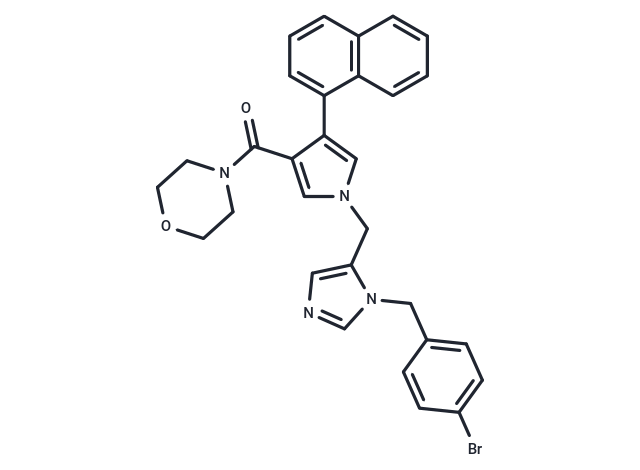Shopping Cart
- Remove All
 Your shopping cart is currently empty
Your shopping cart is currently empty

LB42708 is an orally active farnesyltransferase (FTase) inhibitor (IC50: 0.8/1.2/2.0 nM toward H/N/K-ras).

| Pack Size | Price | Availability | Quantity |
|---|---|---|---|
| 1 mg | 39 € | In Stock | |
| 2 mg | 55 € | In Stock | |
| 5 mg | 83 € | In Stock | |
| 10 mg | 140 € | In Stock | |
| 25 mg | 277 € | In Stock | |
| 50 mg | 414 € | In Stock | |
| 100 mg | 580 € | In Stock | |
| 1 mL x 10 mM (in DMSO) | 128 € | In Stock |
| Description | LB42708 is an orally active farnesyltransferase (FTase) inhibitor (IC50: 0.8/1.2/2.0 nM toward H/N/K-ras). |
| Targets&IC50 | FTase (K-Ras):2.0 nM, FTase (H-ras):0.8 nM, FTase (N-ras):1.2 nM |
| In vitro | In mice treated with lipopolysaccharide (LPS), LB42708 (12.5 mg/kg, intraperitoneally) inhibited the production of nitric oxide (NO), prostaglandin E2 (PGE2), tumor necrosis factor-alpha (TNF-α), and interleukin-1 beta (IL-1β), and suppressed the progression of collagen-induced arthritis (CIA). Additionally, in tumors with either wild-type or mutated Ras, LB42708 (20 mg/kg/day, intraperitoneally) inhibited tumor growth and angiogenesis. |
| In vivo | LB42708 exerts an irreversible inhibitory effect on growth and induces apoptosis in rat intestinal epithelial cells altered by H-ras and K-ras. It inhibits VEGF-induced tumor angiogenesis in tumor-associated endothelial cells by blocking the Ras-dependent MAPK and PI3K/Akt signaling pathways. Additionally, in the murine macrophage lineage RAW264.7 cells, LB42708 significantly inhibits the process of lipopolysaccharide + IFN-γ induced intracellular farnesylation of the protein p21ras. In immune-activated osteoblasts and macrophages, LB42708 suppresses the production of nitric oxide synthase, cyclooxygenase-2, TNF-α, IL-1β, NO, and PGE(2). By inhibiting IKK activity, LB42708 also represses the activation of NF-κB and the activity of the iNOS promoter. |
| Kinase Assay | Biochemical Assessment of PDGFRα Kinase Activity: Chinese hamster ovary (CHO) cells are transiently transfected with mutated or wild type PDGFRα constructs and treated with various concentrations of Crenolanib. Experiments involving recombinant DNA are performed using biosafety level 2 conditions in accordance with guidelines. Protein lysates from cell lines are prepared and subjected to immunoprecipitation using anti-PDGFRα antibodies followed by sequential immunoblotting for PDGFRα. Densitometry is performed to quantify drug effect using Photoshop software, with the level of phosphor- PDGFRα normalized to total protein. Densitometry and proliferation experimental results are analyzed using Calcusyn 2.1 software to mathematically determine the IC50 values. The Wilcoxon Rank Sum Test is used to compare the IC50 values of Crenolanib for a given mutation. |
| Cell Research | Cell growth is measured by MTT. Briefly, cells were seeded at 2 × 103 cells per well in 96-well culture plates in triplicate. After the addition of various concentrations of drugs, cells are incubated for 72 h. At the end of culture, the plates are washed twice with PBS, and cells are incubated with 200 μl of RPMI 1640 containing 10% FCS and 0.25 mg/ml of MTT at 37 °C for 3 h. The absorbance of each well is measured with Titer-Tech 96-well multiscanner at 570 nm. The viable cell number is proportional to the absorbance. (Only for Reference) |
| Molecular Weight | 555.47 |
| Formula | C30H27BrN4O2 |
| Cas No. | 226929-39-1 |
| Smiles | C(=O)(C=1C(=CN(CC=2N(CC3=CC=C(Br)C=C3)C=NC2)C1)C=4C5=C(C=CC4)C=CC=C5)N6CCOCC6 |
| Relative Density. | 1.39 g/cm3 (Predicted) |
| Storage | Powder: -20°C for 3 years | In solvent: -80°C for 1 year | Shipping with blue ice. | ||||||||||||||||||||||||||||||||||||||||
| Solubility Information | Ethanol: 55.6 mg/mL (100 mM) DMSO: 45 mg/mL (81.01 mM), Sonication is recommended. | ||||||||||||||||||||||||||||||||||||||||
Solution Preparation Table | |||||||||||||||||||||||||||||||||||||||||
DMSO/Ethanol
Ethanol
| |||||||||||||||||||||||||||||||||||||||||

Copyright © 2015-2024 TargetMol Chemicals Inc. All Rights Reserved.